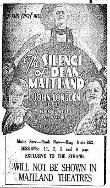AustLit
 1260420295632418136.jpg
1260420295632418136.jpg
Advertisement, The Maitland Daily Mercury, 1 June 1934, p.2 (via Trove Australia)
Adaptation of
The Silence of Dean Maitland
1886
single work
novel
Issue Details:
First known date:
1934...
1934
The Silence of Dean Maitland
The material on this page is available to AustLit subscribers. If you are a subscriber or are from a subscribing organisation, please log in to gain full access. To explore options for subscribing to this unique teaching, research, and publishing resource for Australian culture and storytelling, please contact us or find out more.
Film Details - Cinesound Productions , 1934
Producers:
Ken G. Hall.
Production Companies:
Cinesound Productions.
Director of Photography:
Frank Hurley.
Editors:
William Shepherd.
Music:
Hamilton Webber.
Cast:
Including John Longden (Dean Cyril Maitland), Charlotte Francis (Alma Lee), Constance Worth (Alma Gray), John Warwick (Dr Henry Everard), John Pickard (Tommy Everard), Patricia Minchin (Marion Everard), Audrey Nicholson (Lillian Maitland), Bill Kerr (Cyril Maitland Jr.), Fred MacDonald (Granfer), George Lloyd (Bill Grove), Claude Turton (Charlie Gray), W. Lane-Bayliff (Reverend Maitland, Senior), Les Warton (Ben Lee), and Leal Douglas (Mrs Lee).
Release Dates:
May 1934 (Australia).
Awards:
- Second place in a 1935 Commonwealth film competition, winning £1,250.
Notes:
1. The two lead actors, John Longden and Charlotte Francis, were British actors touring Australia in a stage play when they were cast.
2. The film was highly popular at the Australian box office and secured release in the UK, where box-office receipts were also good.
3. The film attracted the attention of W. Creswell O'Reilly, chief film censor. According to an article in the Sydney Morning Herald (Fri. 11 May 1934), 'In excising three scenes from "The Silence of Dean Maitland" (which was shown to representatives of the Press a few weeks ago) Mr. O'Reilly seems to have applied a much stricter standard than is applied, so far as an outside observer can judge, to the general run of English and American pictures. In one of the three scenes objected to the girl Alma Lee is revealed in a degree of undress which is constantly equalled and sometimes exceeded in American films passed by the censor. The second scene, which shows a passionate meeting between the hero and Alma Lee is handled skilfully and without undue emphasis. The reticence of the treatment in this scene is at least equal to that given to similar scenes in imported films. Also, the incident is vital to the plot. Regarding the third of the scenes that are in question (showing a village oaf sniggering as he catches a glimpse of Alma Lee bathing) most people would probably agree heartily with Mr. O'Reilly, not only because the joke is a cheap one, but also because it is irrelevant to the development of the story. As readers of this once-popular tale will recall, it is difficult to imagine a story in which the wages of sin are more sternly exacted' (p.11).
In an article in the Argus (Thurs. 17 May 1934), which notes that the censor has allowed the scenes to stand with some minor modifications, 'Mr Ken Hall, general manager of Cinesound Ltd and director of the film, said to-day that he was particularly pleased that the love scene between the dean and the girl had been allowed to remain because it formed the dramatic pivot of the play' (p.10).


